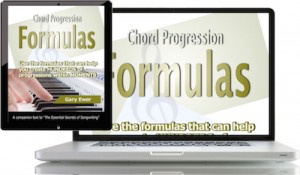A modal scale, for the purposes of what you’ll need to know for good songwriting, is one that starts and finishes on the non-tonic note of a major scale. That may seem like a mouthful, but here’s all it means:
If you play a C major scale, you’re playing the notes C-D-E-F-G-A-B-C. But let’s say that you start on D, and play that very same sequence of notes, ending on the D above. That gives you the notes D-E-F-G-A-B-C-D. That’s called a dorian scale. Just as with a C major scale, you can then go ahead and create chord progressions that make D (instead of C) sound like the “tonic” note, like this one:
Dm G F Am Dm
You can use each note of a C major scale as a potential “tonic,” building a scale that starts and ends on a note other than C. One common choice is to start and end on G: G-A-B-C-D-E-F-G. That’s called a mixolydian scale, and if you play it, you’ll notice that it sounds very much like a major scale, with the small exception that it ends with a whole tone — F to G — rather than a major scale, which ends with a semitone.
 “Chord Progression Formulas” make it easy to create many progressions using one simple formula. If you’re a chords-first songwriter, this eBook will speed up your process and get you writing and finishing songs faster than you’ve done before. Get it separately, or as part of “The Essential Secrets of Songwriting 10-eBook Bundle.”
“Chord Progression Formulas” make it easy to create many progressions using one simple formula. If you’re a chords-first songwriter, this eBook will speed up your process and get you writing and finishing songs faster than you’ve done before. Get it separately, or as part of “The Essential Secrets of Songwriting 10-eBook Bundle.”
That so-called lowered 7th gives a beautifully unexpected touch to many chord progressions. The lowered 7th specifically means two things:
- The flat-VII chord works really nicely. Example: G F C G (I VII IV I)
- The V-chord will be a minor (not a major) chord. Example: G F C Dm G (I VII IV v I)
A lowered 7th has the effect of “darkening” the sound of your music, because it allows for the minor-V chord, so your progressions will be very useful for melancholy or edgier melodies, lyrics and musical arrangements.
And of course, you can transpose the music to whichever “tonic” you like. What follows are 5 chord progressions that all use G as the mixolydian tonic, but they’re listed using Roman numerals for easy transposition. Minor chords (like the minor v-chord) are shown with a lowercase Roman numeral. Chords with a slash indicate the chord itself (the letter name to the left of the slash) and the suggested bass note (to the right of the slash).
- G C Dm G (I IV v I)
- G Am C G/B C Dm G (I ii IV I6 IV v I)
- G F C/E Cm/Eb Dm C G (I VII IV6 iv6 v IV I)
- G Dm G F C Dm G (I v I VII IV v I)
- G G/B C G F C G (I I6 IV I VII IV I)
 Written by Gary Ewer. Follow on Twitter.
Written by Gary Ewer. Follow on Twitter.
“Essential Chord Progressions” give you hundreds of progressions you can use as is, or modify to suit the songs you’re working on. If all you need are some chords to get you going, check out this ebook collection.
give you hundreds of progressions you can use as is, or modify to suit the songs you’re working on. If all you need are some chords to get you going, check out this ebook collection.











Hi,huge thanks for your amazing book and lessons,I found your Strong-fragile progression table of your book so useful for major and minor scales but I have not found such table for other 5 modes,please make a similar table for them too.I also saw your mentioned example above for G mixolydian but still feel C note as root and final note ,what is the problem?thanks alot
Hi Alireza:
There’s no problem there, but what’s happening is that you’re hearing C as the tonal centre. Sometimes that happens, and the best way to reinforce the feeling of G as a “tonic” or root is to move from G to some other chord, then back to G once more. In practical usage, a chord at the end of a progression might sound a bit more final if it’s held for a longer period of time than the chords that precede it.
-Gary
Thanks a lot Gary. I hope in he feature you make more great lessons about modes and the reasons of tonality (why and how a note sounds tonic).